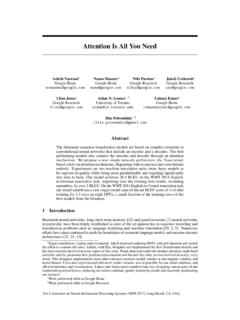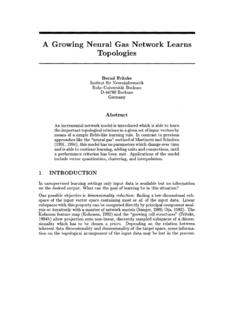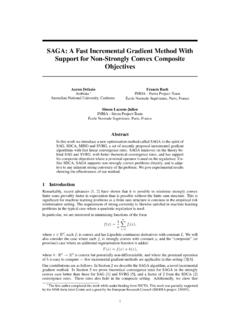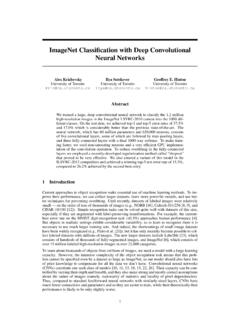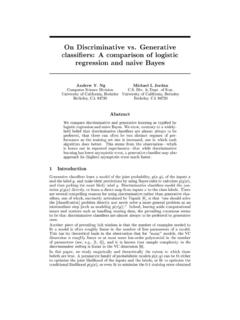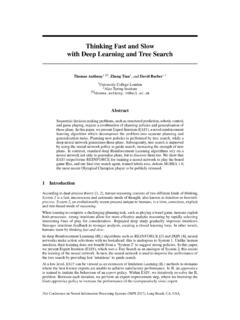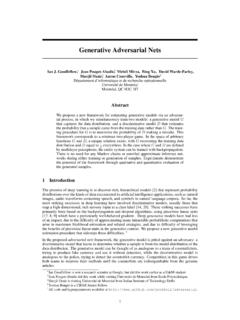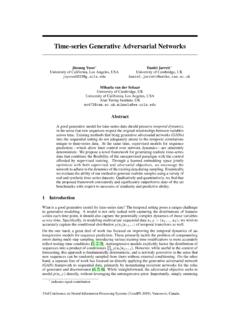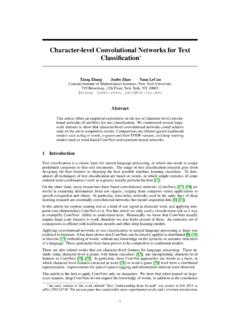Transcription of InfoGAN: Interpretable Representation Learning by ...
1 InfoGAN: Interpretable Representation Learning byInformation Maximizing Generative Adversarial NetsXi Chen , Yan Duan , Rein Houthooft , John Schulman , Ilya Sutskever , Pieter Abbeel UC Berkeley, Department of Electrical Engineering and Computer Sciences OpenAIAbstractThis paper describes InfoGAN, an information -theoretic extension to the Gener-ative Adversarial Network that is able to learn disentangled representations in acompletely unsupervised manner. InfoGAN is a generative adversarial networkthat also maximizes the mutual information between a small subset of the latentvariables and the observation. We derive a lower bound of the mutual informationobjective that can be optimized efficiently. Specifically, InfoGAN successfullydisentangles writing styles from digit shapes on the MNIST dataset, pose fromlighting of 3D rendered images, and background digits from the central digit onthe SVHN dataset.
2 It also discovers visual concepts that include hair styles, pres-ence/absence of eyeglasses, and emotions on the CelebA face dataset. Experimentsshow that InfoGAN learns Interpretable representations that are competitive withrepresentations learned by existing supervised methods. For an up-to-date versionof this paper, please IntroductionUnsupervised Learning can be described as the general problem of extracting value from unlabelleddata which exists in vast quantities. A popular framework for unsupervised Learning is that ofrepresentation Learning [1, 2], whose goal is to use unlabelled data to learn a Representation thatexposes important semantic features as easily decodable factors. A method that can learn suchrepresentations is likely to exist [2], and to be useful for many downstream tasks which includeclassification, regression, visualization, and policy Learning in reinforcement unsupervised Learning is ill-posed because the relevant downstream tasks are unknown attraining time, adisentangled Representation , one which explicitly represents the salient attributes of adata instance, should be helpful for therelevantbut unknown tasks.
3 For example, for a dataset offaces, a useful disentangled Representation may allocate a separate set of dimensions for each of thefollowing attributes: facial expression, eye color, hairstyle, presence or absence of eyeglasses, and theidentity of the corresponding person. A disentangled Representation can be useful for natural tasksthat require knowledge of the salient attributes of the data, which include tasks like face recognitionand object recognition. It is not the case for unnatural supervised tasks, where the goal could be,for example, to determine whether the number of red pixels in an image is even or odd. Thus, to beuseful, an unsupervised Learning algorithm must in effect correctly guess the likely set of downstreamclassification tasks without being directly exposed to significant fraction of unsupervised Learning research is driven by generative modelling.
4 It ismotivated by the belief that the ability to synthesize, or create the observed data entails some formof understanding, and it is hoped that a good generative model will automatically learn a disentangledrepresentation, even though it is easy to construct perfect generative models with arbitrarily badrepresentations. The most prominent generative models are the variational autoencoder (VAE) [3]and the generative adversarial network (GAN) [4].30th Conference on neural information Processing Systems (NIPS 2016), Barcelona, this paper, we present a simple modification to the generative adversarial network objective thatencourages it to learn Interpretable and meaningful representations. We do so by maximizing themutual information between a fixed small subset of the GAN s noise variables and the observations,which turns out to be relatively straightforward.
5 Despite its simplicity, we found our method to besurprisingly effective: it was able to discover highly semantic and meaningful hidden representationson a number of image datasets: digits (MNIST), faces (CelebA), and house numbers (SVHN). Thequality of our unsupervised disentangled Representation matches previous works that made use ofsupervised label information [5 9]. These results suggest that generative modelling augmented witha mutual information cost could be a fruitful approach for Learning disentangled the remainder of the paper, we begin with a review of the related work, noting the supervision that isrequired by previous methods that learn disentangled representations. Then we review GANs, whichis the basis of InfoGAN.
6 We describe how maximizing mutual information results in interpretablerepresentations and derive a simple and efficient algorithm for doing so. Finally, in the experimentssection, we first compare InfoGAN with prior approaches on relatively clean datasets and thenshow that InfoGAN can learn Interpretable representations on complex datasets where no previousunsupervised approach is known to learn representations of comparable Related WorkThere exists a large body of work on unsupervised Representation Learning . Early methods were basedon stacked (often denoising) autoencoders or restricted Boltzmann machines [10 13].Another intriguing line of work consists of the ladder network [14], which has achieved spectacularresults on a semi-supervised variant of the MNIST dataset.
7 More recently, a model based on theVAE has achieved even better semi-supervised results on MNIST [15]. GANs [4] have been used byRadford et al. [16] to learn an image Representation that supports basic linear algebra on code et al. [17] have been able to learn representations using probabilistic inference over Bayesianprograms, which achieved convincing one-shot Learning results on the OMNI addition, prior research attempted to learn disentangled representations using supervised class of such methods trains a subset of the Representation to match the supplied label usingsupervised Learning : bilinear models [18] separate style and content; multi-view perceptron [19]separate face identity and view point; and Yanget al.
8 [20] developed a recurrent variant that generatesa sequence of latent factor transformations. Similarly, VAEs [5] and Adversarial Autoencoders [9]were shown to learn representations in which class label is separated from other several weakly supervised methods were developed to remove the need of explicitlylabeling variations. disBM [21] is a higher-order Boltzmann machine which learns a disentangledrepresentation by clamping a part of the hidden units for a pair of data points that are known tomatch in all but one factors of variation. DC-IGN [7] extends this clamping idea to VAE andsuccessfully learns graphics codes that can represent pose and light in 3D rendered images. This lineof work yields impressive results, but they rely on a supervised grouping of the data that is generallynot available.
9 Whitneyet al.[8] proposed to alleviate the grouping requirement by Learning fromconsecutive frames of images and use temporal continuity as supervisory the cited prior works that strive to recover disentangled representations, InfoGAN requiresno supervision of any kind. To the best of our knowledge, the only other unsupervised method thatlearns disentangled representations is hossRBM [13], a higher-order extension of the spike -and-slabrestricted Boltzmann machine that can disentangle emotion from identity on the Toronto Face Dataset[22]. However, hossRBM can only disentangle discrete latent factors, and its computation cost growsexponentially in the number of factors. InfoGAN can disentangle both discrete and continuous latentfactors, scale to complicated datasets, and typically requires no more training time than Background: Generative Adversarial NetworksGoodfellowet al.
10 [4] introduced the Generative Adversarial Networks (GAN), a framework fortraining deep generative models using a minimax game. The goal is to learn a generator distributionPG(x)that matches the real data distributionPdata(x). Instead of trying to explicitly assign probabilityto everyxin the data distribution, GAN learns a generator networkGthat generates samples from2the generator distributionPGby transforming a noise variablez Pnoise(z)into a sampleG(z).This generator is trained by playing against an adversarial discriminator networkDthat aims todistinguish between samples from the true data distributionPdataand the generator s for a given generator, the optimal discriminator isD(x) =Pdata(x)/(Pdata(x) +PG(x)). Moreformally, the minimax game is given by the following expression:minGmaxDV(D,G) =Ex Pdata[logD(x)] +Ez noise[log (1 D(G(z)))](1)4 Mutual information for Inducing Latent CodesThe GAN formulation uses a simple factored continuous input noise vectorz, while imposing norestrictions on the manner in which the generator may use this noise.
